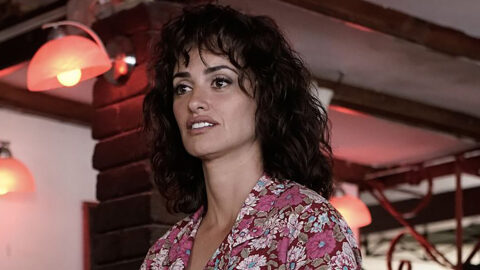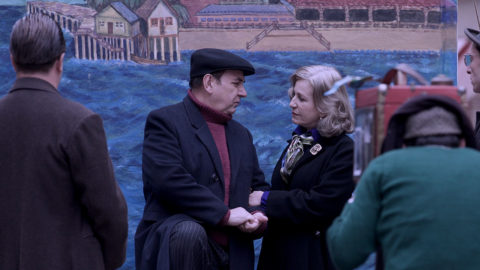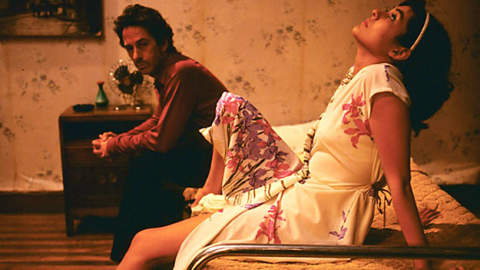Interview: Pablo Larraín
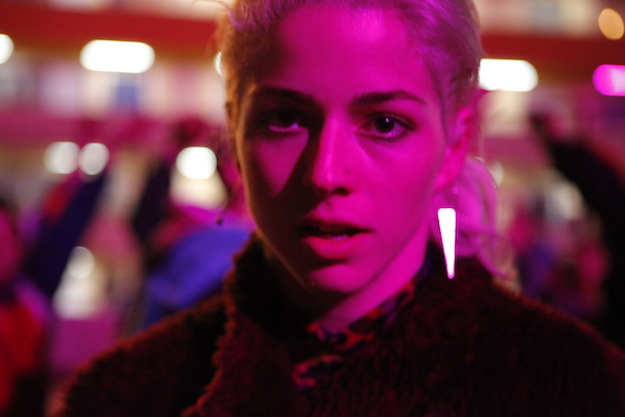
Ema (Pablo Larraín, 2019)
The title character of Pablo Larraín’s Ema has a passion for reggaeton and dance, and a penchant for going into the streets with a flamethrower to burn stuff. She’s also the bereft mother of an adopted child whom she and her husband, Gaston (Gael Garcia Bernal), have given up after a violent incident. Ema is, in a word, complex, and Larrain’s portrait of her and her fellow dancers—fussily directed by Gaston—obeys her centrifugal force, spinning out scenes from a life of freedoms and frustrations. Filming in Valparaiso, the Chilean director hitches the film’s volatile energies to those of Ema, played by Mariana Di Girolamo, who has been better known for soap operas. She brings a strange enchantment and sly wit to a film that’s very nearly flying apart into pieces, as Larrain enacts unpredictable montage and staging that keeps us off-balance, shuttling between hope and fury; you might add Ema as a twist in a triptych alongside the independent forces of Neruda and Jackie. I spoke with the filmmaker in Venice where Ema screened in competition before heading to the Toronto International Film Festival.
What was the origin of the film? Did you know an “Ema”?
The real origin is related to adoption. I think adoption is one of the most generous things a person can do, but it’s usually idealised somehow. There are a lot of problematic circumstances that parents go through, and sometimes the children bring some sort of trauma because they’ve been abused. And there’s a small amount of people that actually return the child, and that is called a “failed adoption.” It’s a bureaucratic logic but basically what happens is: if I give up a son for adoption, then legally that person is not my son and has a different name, and then a family comes in and adopts that person, and he becomes their son. And when they return it, he’s again an orphan that has a different name and was never the son of the previous people.
It’s like erasing a personal history?
Yeah, so there’s an absurdity around it that’s very painful and traumatising. That’s where we started, and originally the character was going to be played by an older woman, like 45, and then we said, no, 65, and then [we thought] what if she’s younger? Then I met Mariana and we did the movie around her. When we did that, we wanted to make her a dancer and [make] what they listen to, reggaeton. And we realised we were talking about a generation that isn’t mine and is very different from mine. I am of a generation from the previous century, and this is a generation from this century—you name it whatever you want—and they live with a completely different logic, structure, values. I got completely fascinated by this complex woman.
Did you talk about this with Mariana?
Yeah and also some younger people. They are people who are very particular and, in their way, can be very conservative. They really care, for example, about climate change. And not, like, recycling, but really caring, thinking, talking, and being active about it. They live with very few things. The logic of consumerism is completely different from them than for my generation. They just want a good computer, a good phone, a few clothes, and to minimize their necessity of practical and physical things. They also feel that love, sensuality, sexuality is not binary, and not like the late ’60s. They’re very individualistic but in a way they’re very respectful for others. So here is a character that can be extremely poetic in a movie and can deliver many different emotions and crises and accidents.
So you see a source of tension between this character and the responsibility of having a child.
Yeah. It’s kind of ridiculous, but I do think she represents Mother Nature in the movie, because she’s a mother, a sister, a daughter, a lover, a wife, a dancer, and she’s the sun. In mythology, the sun is male, and the moon is feminine, and I think what we are doing here is that she is the sun and everyone is rotating around the sun, around her.
Ema and her fellow dancers love reggaeton and you stage this terrific conversation about the music, between them and their dance choreographer Gastón (Gael Garcia Bernal). It really works out how the music functions.
You can’t escape music that is pop and noisy and everything, in the airport, shops, streets, discotheques, bars, people’s apartments, coming out of cars, windows, everywhere. And like anything from pop culture, it’s there even if you don’t use it, and you consume that material. Reggaeton has that sort of quality in that it brings this sort of division, and it’s also been called misogynist, the way that the female is portrayed, based on their bodies. What I think is interesting is you go and say that to a woman who is actually dancing reggaeton, and they will say, who the fuck are you to tell me what to dance to or not, what are you talking about? I dance to whatever I want, and I feel when I’m dancing to this music, I’m having sex with all the people who are dancing without even touching them. And when I heard that, I was like, “Okay, we’re gonna put that in the movie.”
So that was a description that came from talking to someone?
Well, a little bit, but also something that [co-screenwriter] Guillermo [Calderón] wrote, and part of it that Gael brought to the scene too. It could have been longer. It’s the friction between those generations—Gastón is used to being in big spaces, theatres, and he controls the dancers, and he’s like a little god and he tells them what to do, what not to do, how to move, do this, do that. He has this world around contemporary dance, which is, by the way, very beautiful and I love it. But in the movie, the dancers think what he’s doing is just old-fashioned, that it’s completely unrelated to what’s going on in the street and what people are doing, and they’re telling him that: your work as a contemporary dancer is not really reflecting what’s going on, and it doesn’t reflect us, and it doesn’t bring our spirit onto your stage. We’re going to do it in the street, not on your stage, because that’s where things happen, and you know what? We’re going to go burn that fucking street too, because we want to leave a trace, that’s who we are, we leave traces, and that’s our legacy, and that’s our testimony. And it will vanish, because they don’t have the potential just to do and create something that will stay in time. Their actions are meant and created to disappear. And that is something that is fascinating, because it’s like a happening; it’s something that’s created to be evaporated. And it leaves a trace only in your memory. You can see their traces; you can see what they’re going through just by looking at them.
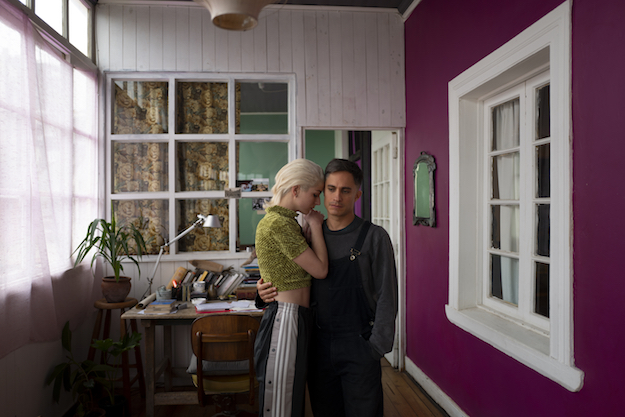
I was thinking a lot about the editing in this film, not just in the dance scenes, because you’re building on some of what you do in Jackie and Neruda. There’s a way the scenes are cut together, side by side, not for the pleasure of the narrative always, not for us to enjoy the storytelling per se—I felt like we are in her head. Does that make sense?
Yeah. You’re talking about empathy. You’re talking about how culture and how some mainstream movies create a logic of empathy and how we should relate to the characters, and that is something that is based on a structure, on how you can basically understand and follow whatever we’re following through very specific conventions. So when those structures and tones are challenged, things like that happen, and you ask that question, and I completely understand. The other way to do it would be more classical. I would have to basically humiliate the character in the first 30 minutes at least four or five times, make her regret, and make her understand she made a mistake. And then the second act would basically be the story of a woman who struggles to understand herself and forgive herself, and to find this boy, and the third one we have a family—can the family be together? All this is in the movie, but it’s just in a way that’s more internal and it’s not put in a way that’s more classical. Not because I want to walk away from what’s classical—I just think when something’s internal, it’s really internal, it’s happening inside the mind of the character. That’s where I would like the audience to be.
You’re also encouraging getting into someone’s head with a lot of the frontal shots, almost looking at the camera.
But they don’t look at the camera. It’s close, but they don’t look at the camera.
It almost looks like it.
It would be if I was looking at you like this. [Looks at, I think, my forehead] I’m not looking at you, but if you’re looking at the camera it’s like you break the wall and I don’t do that. I’ve tried but I always take it out.
Mariana Di Girolamo has such a fascinating presence on screen. What qualities made you cast her?
She has something very unique, and she’s very particular, and can be a giant and a very fragile little person in the same moment. So she can be very close and very far too, and I wanted to have that in the character. I wanted to have in the movie, just like dance, in the old-fashioned way, when you’re dancing and you’re far from the character, and then you’re close and you have more empathy, and because of the things she does, she moves away from you, depending on your choreography, and then you’re back. I thought she had that ability to be indescribable, and that’s why it’s so fascinating to read how they describe her, because I don’t think it’s possible. It’s really hard because it’s something you cannot put in words, and that’s exactly what cinema does.
So I wanted to have a movie that is completed by the audience. Anyone that through their own biography, their own relationship with family, with children, fathers, mothers, siblings, everything or anything—your own biography will complete what we’re seeing, will determine ultimately what we’re seeing, so the movie should work differently. It’s kind of a dream.
I for one started thinking of Pasolini’s Teorema.
Thank you, you’re the only person that actually saw it. It’s like Teorema in the way that Terence Stamp shows up and everyone changes because of his presence. He leaves the family, and everyone was transformed. Ema stays, but it’s a movie that I love very, very much, and I was thinking about it when we did this.
I wanted to ask finally about the ending of Ema. Without going into detail, it seems to change our sense of her motivations. Is it fair to call it a kind of poetic justice?
I think that I would say it’s like a cosmic balance that is reached in that room. And they’re all together, and they’re family, even if they walk away from there, they will still be a family, and that’s the trace. I love “poetic justice” but I don’t think justice could be applied to this, because I don’t know what that is anymore, but I would say that there’s some kind of balance that is sort of cosmic in the way that it’s very linked to nature. I think she represents nature, and nature finds balance.
So often in your films there’s a combination of the beautiful and the painful or violent, and after this one and how it looks at things, it’s interesting to see what you do next.
I remember an early interview that Tim Burton did, and he said someone said to him, oh your movies are so dark, and he said, yeah, but that’s the only way you can actually see the light. It’s almost a cliché, but it stayed with me, and it’s so true. And people are afraid of darkness—why? We all live and struggle in our own darkness, and I think cinema has to portray that. Sometimes we do it better, sometimes it works out and it connects with more or less people, but that’s the job: to create a reflection that could go anywhere.
Nicolas Rapold is the editor-in-chief of Film Comment and hosts The Film Comment Podcast.



